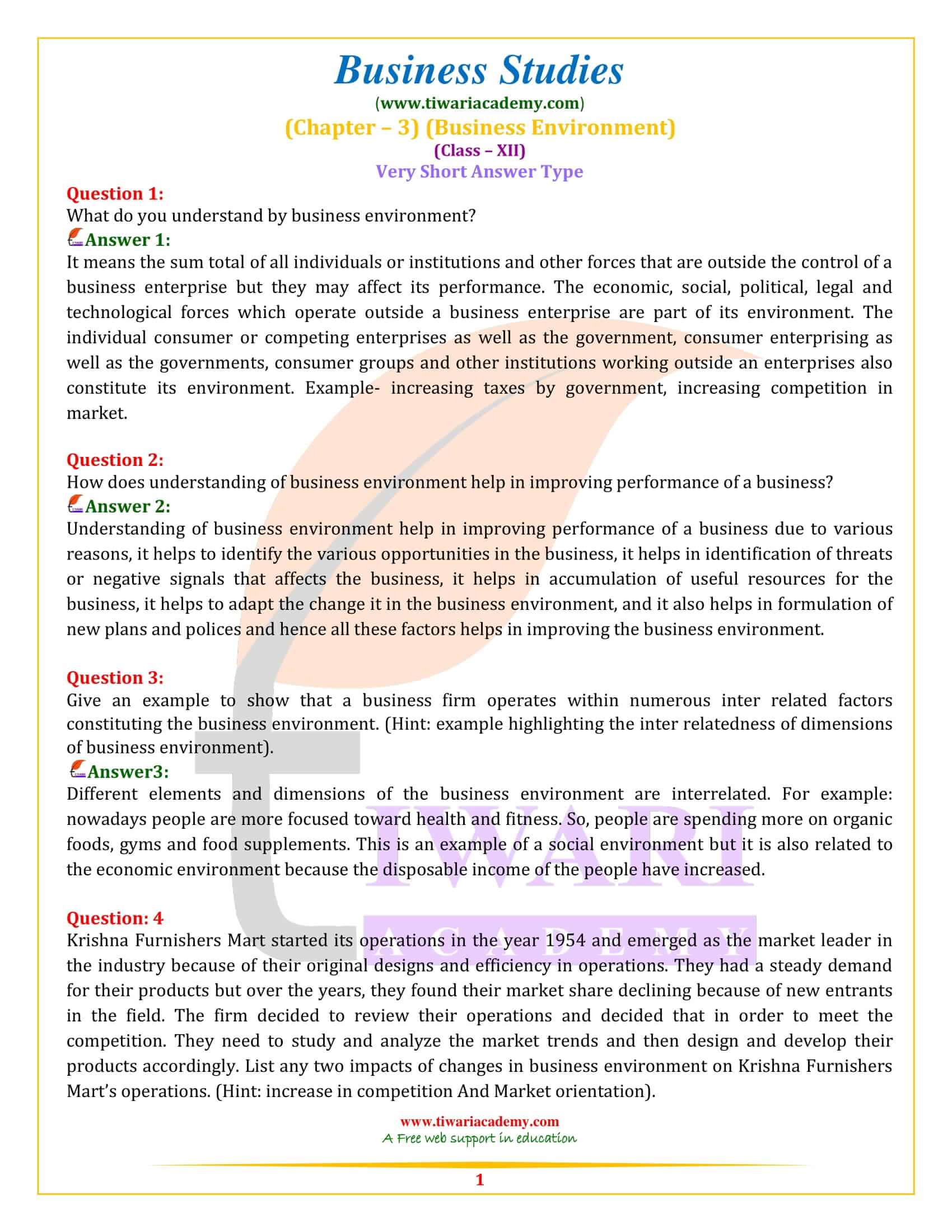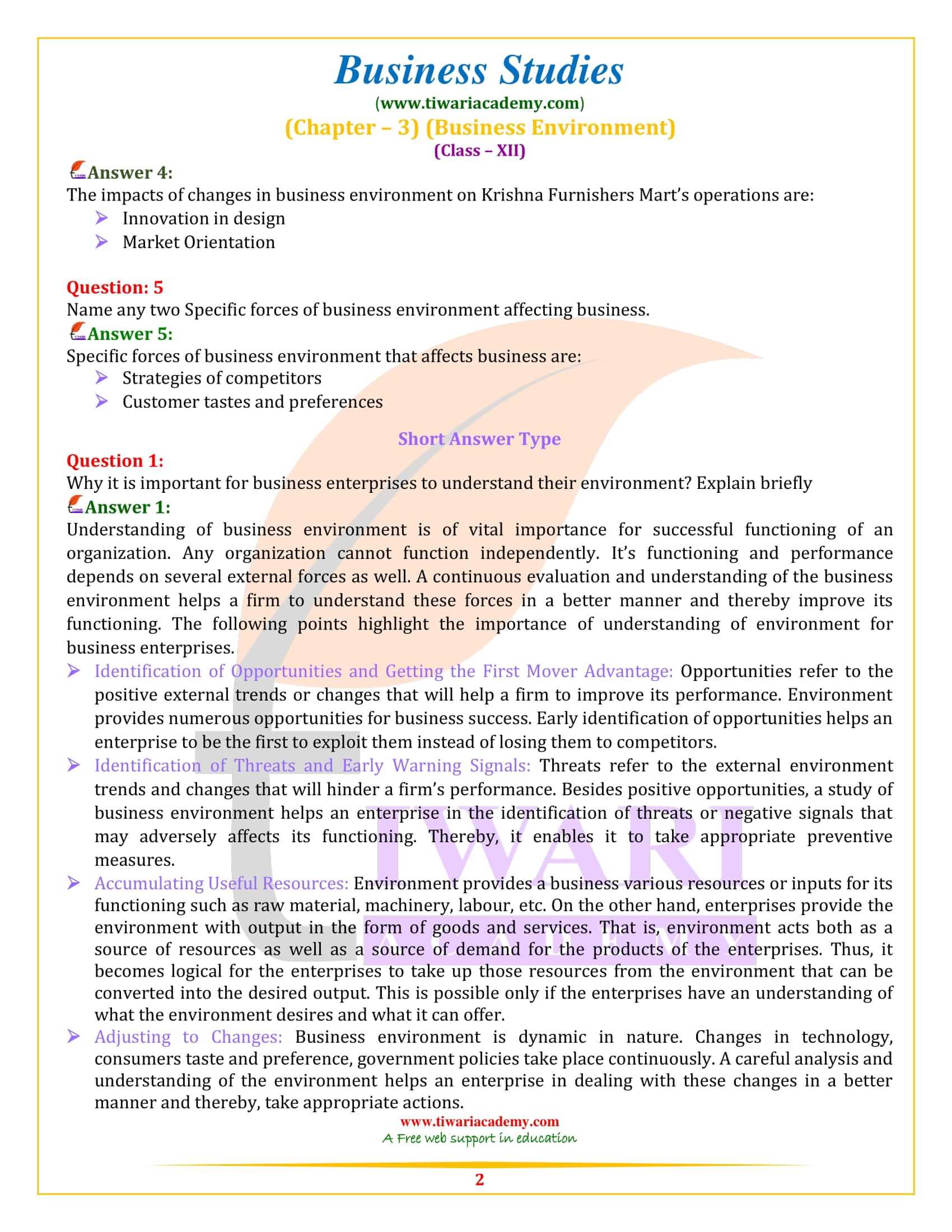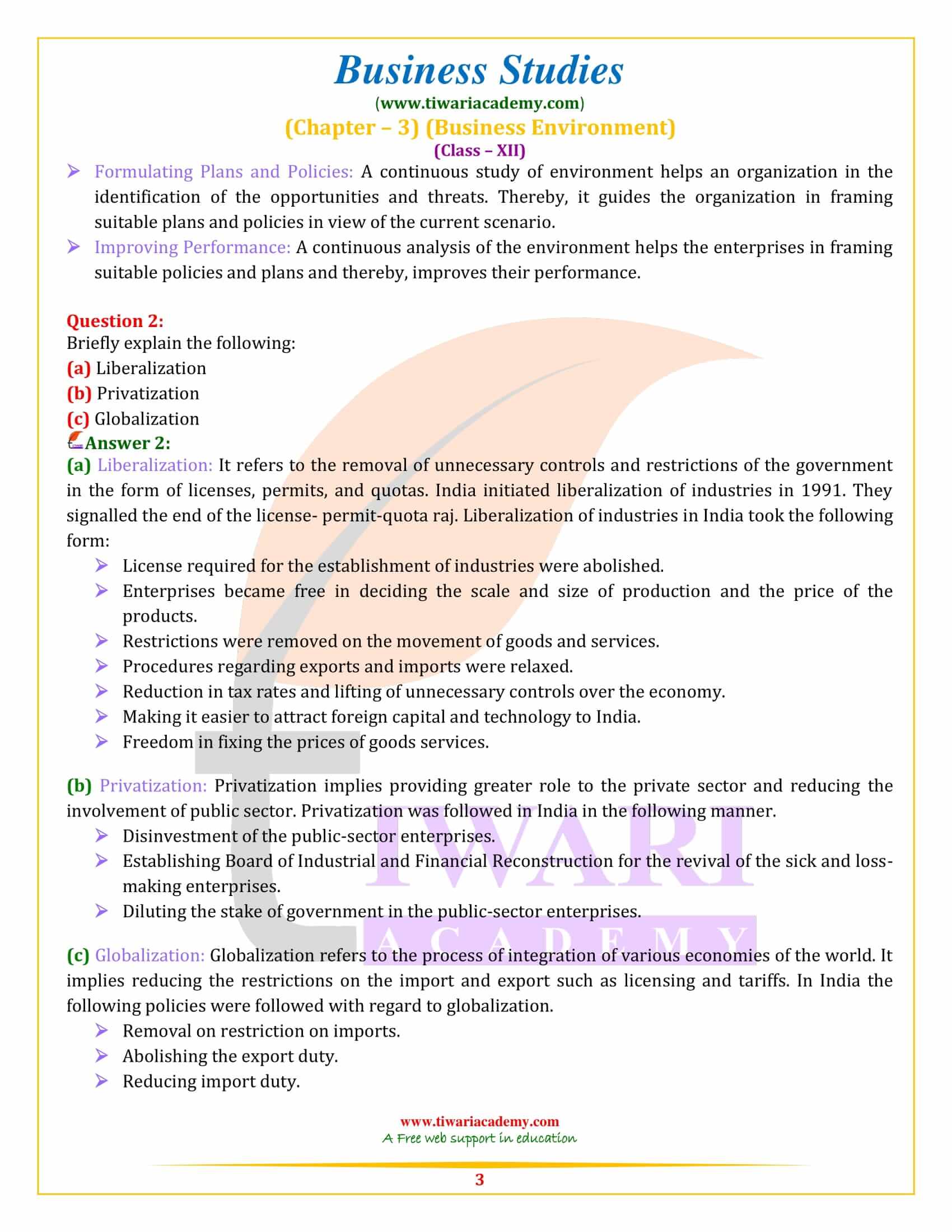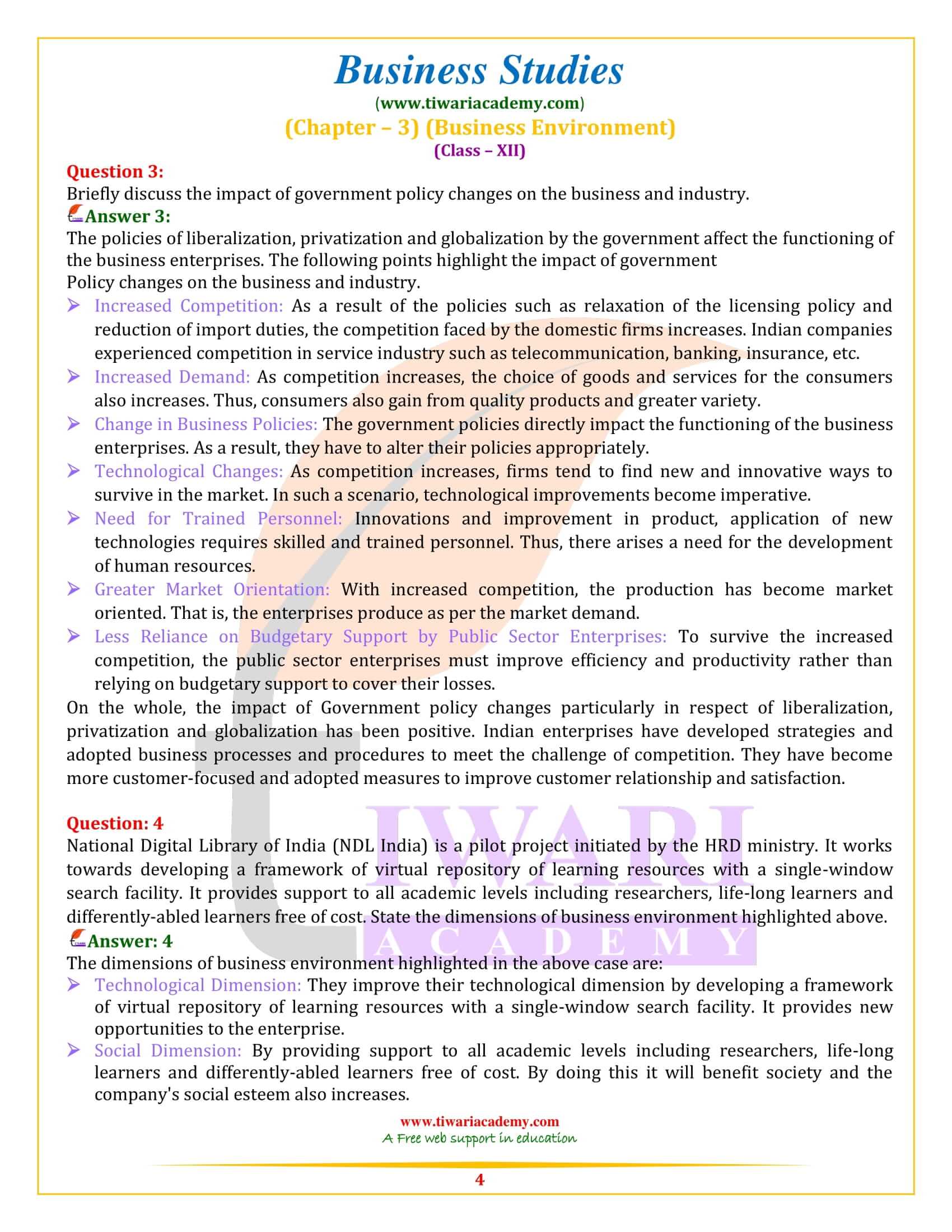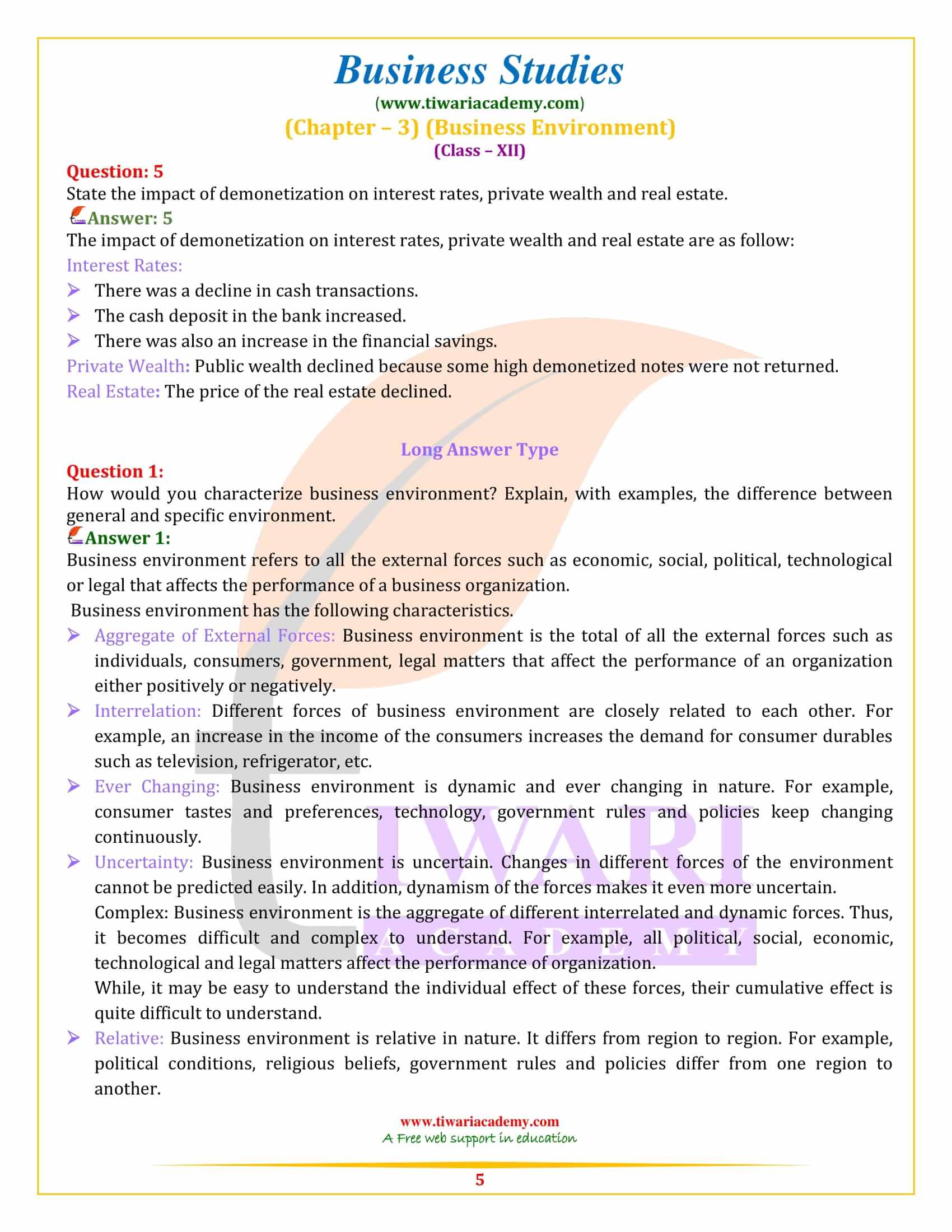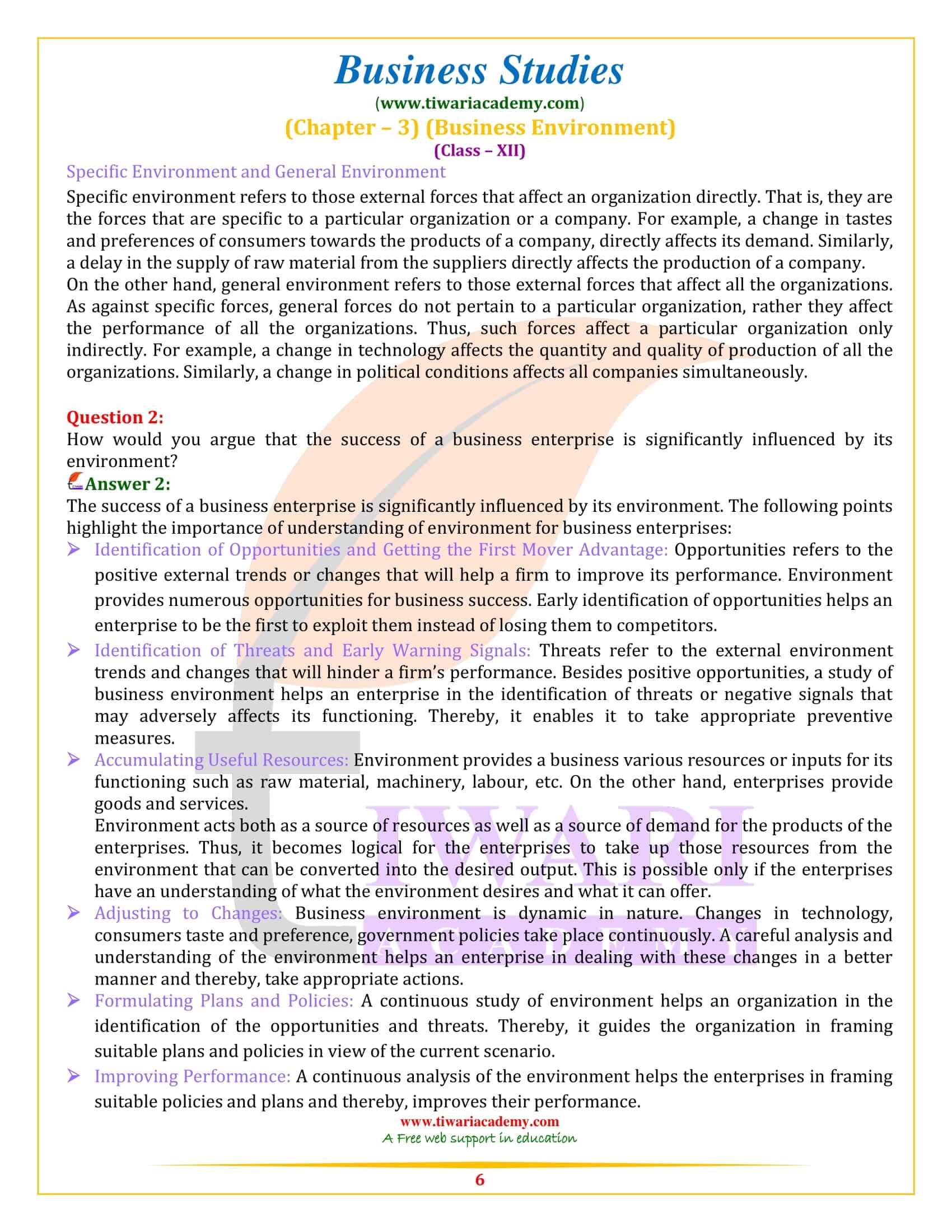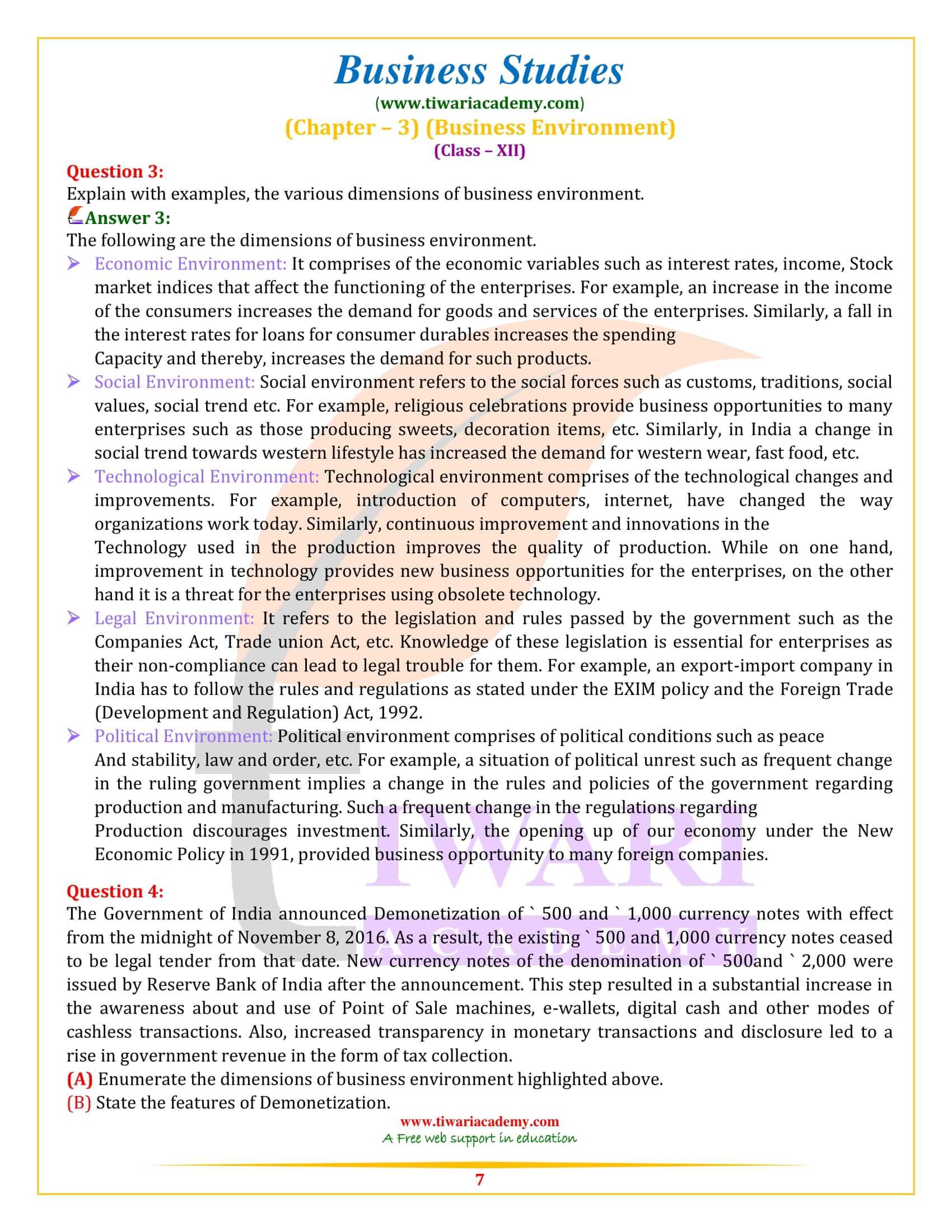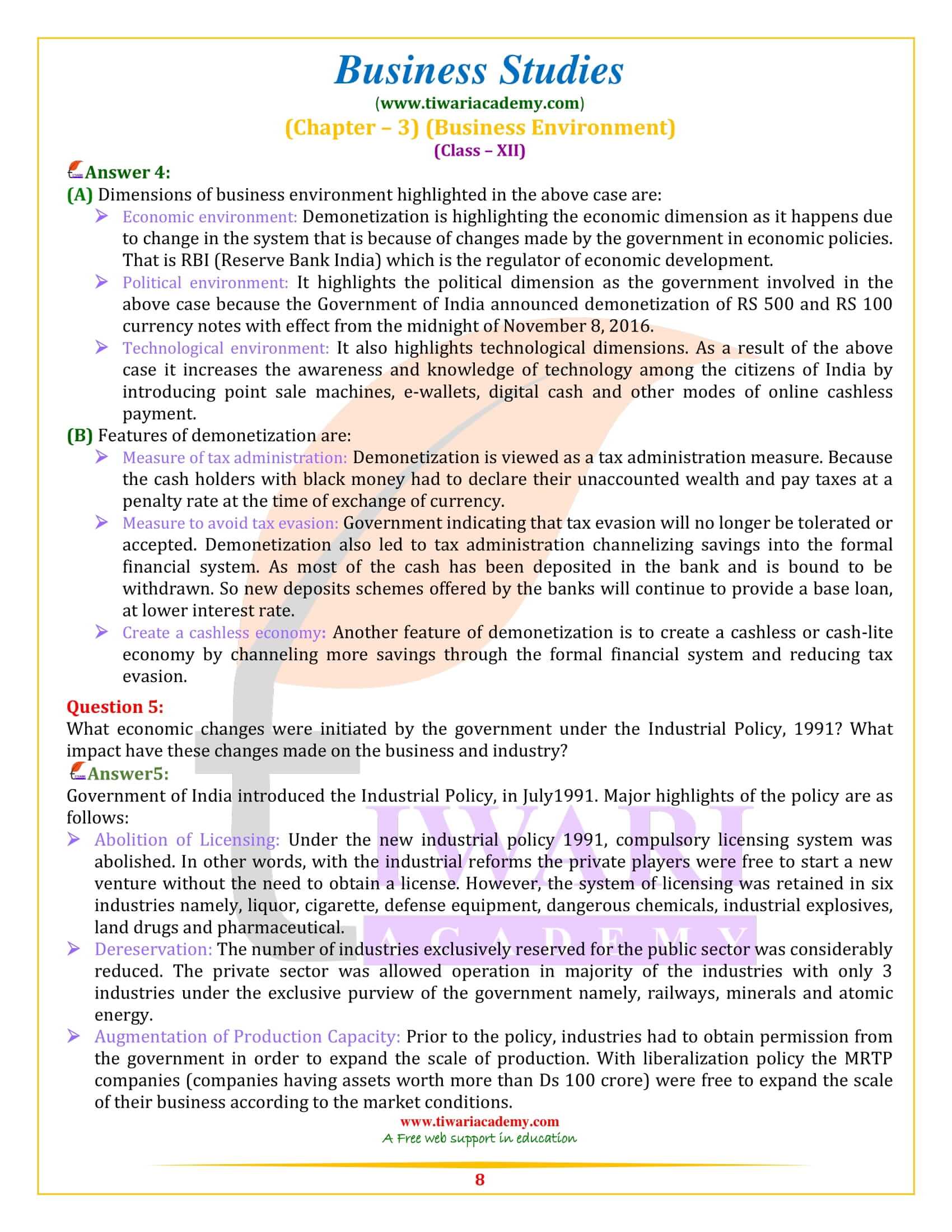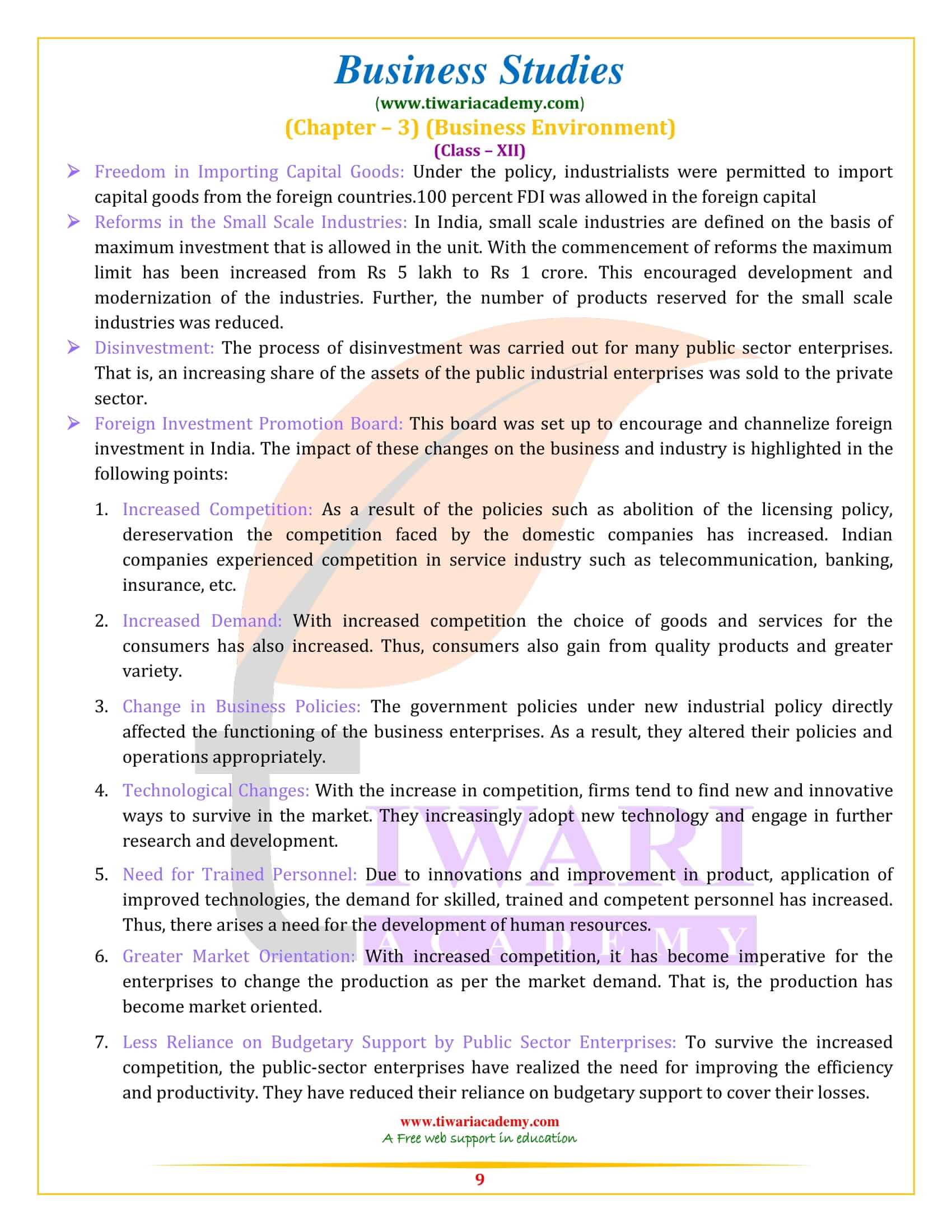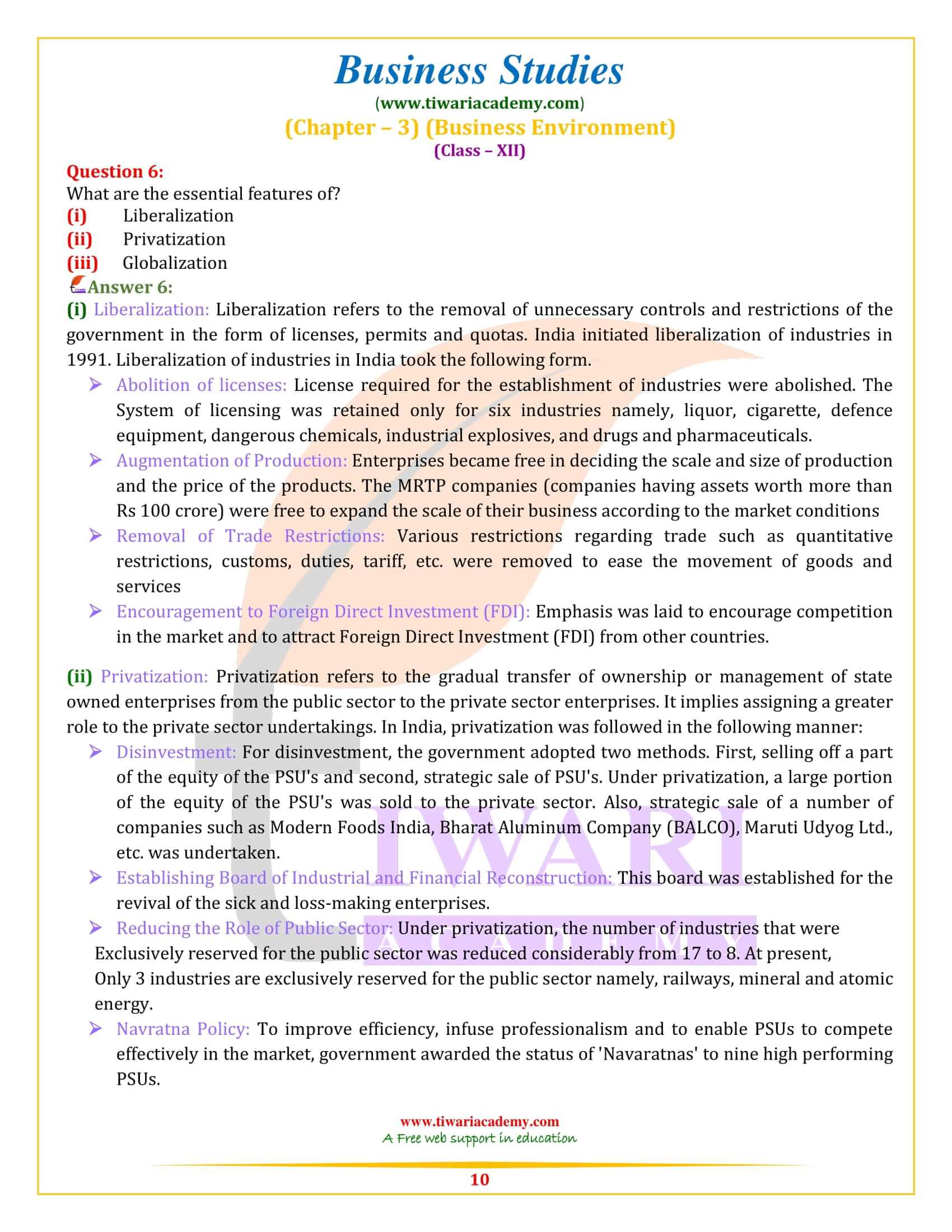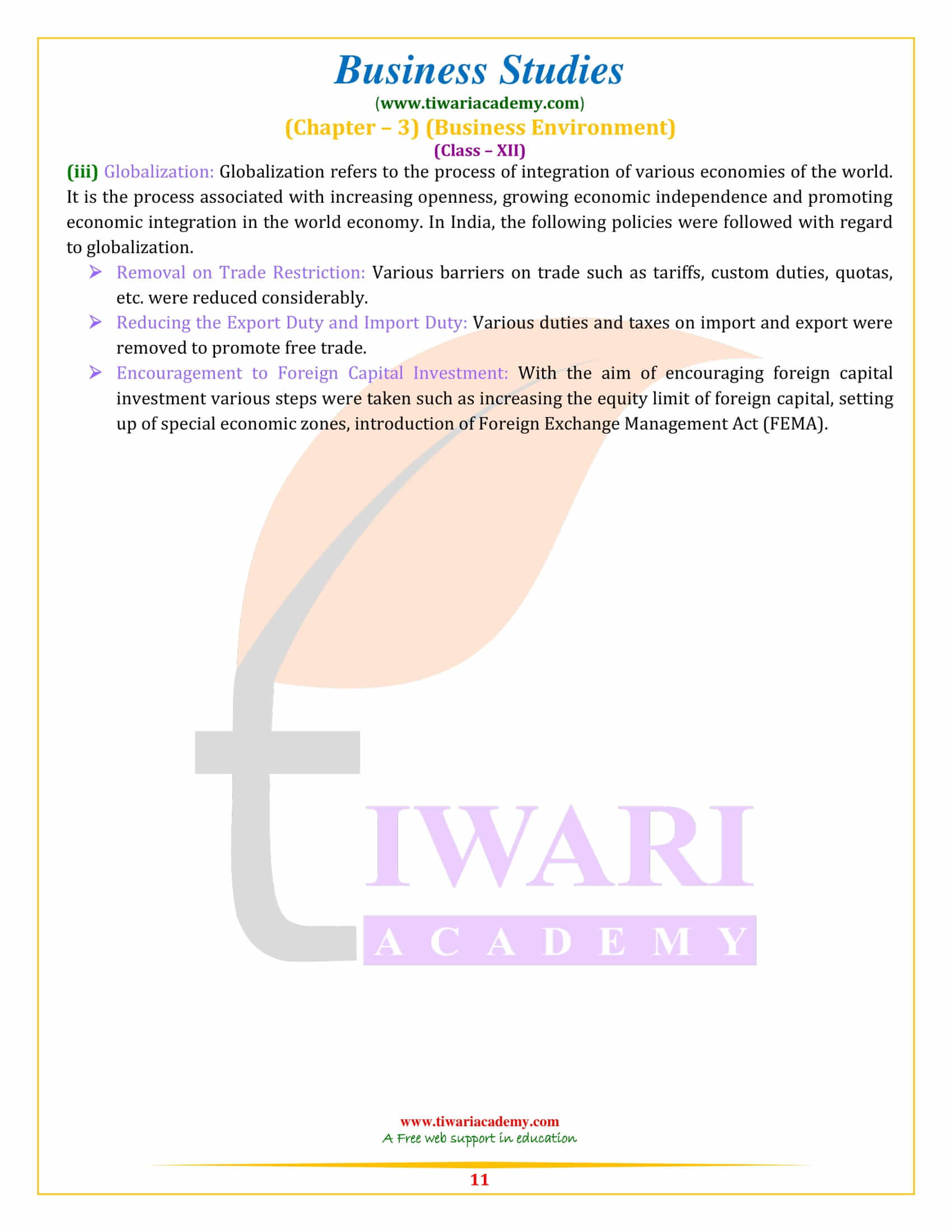NCERT Solutions for Class 12 Business Studies Chapter 3 Business Environment updated for new academic session 2025-26. All the answers of Class 12 B. St. Chapter 3 are given here in simplified format. Use it free of cost without any login.
Hints of Viva Voice for Class 12 Business Studies
NCERT Solutions for Class 12 Business Studies Chapter 3
Class 12 Business Studies Chapter 3 NCERT Solutions
Very Short Answer Type
What do you understand by business environment?
It means the sum total of all individuals or institutions and other forces that are outside the control of a business enterprise but they may affect its performance. The economic, social, political, legal and technological forces which operate outside a business enterprise are part of its environment. The individual consumer or competing enterprises as well as the government, consumer enterprising as well as the governments, consumer groups and other institutions working outside an enterprises also constitute its environment. Example- increasing taxes by government, increasing competition in market.
How does understanding of business environment help in improving performance of a business?
Understanding of business environment help in improving performance of a business due to various reasons, it helps to identify the various opportunities in the business, it helps in identification of threats or negative signals that affects the business, it helps in accumulation of useful resources for the business, it helps to adapt the change it in the business environment, and it also helps in formulation of new plans and polices and hence all these factors helps in improving the business environment.
Give an example to show that a business firm operates within numerous inter related factors constituting the business environment. (Hint: example highlighting the inter relatedness of dimensions of business environment).
Different elements and dimensions of the business environment are interrelated. For example: nowadays people are more focused toward health and fitness. So, people are spending more on organic foods, gyms and food supplements. This is an example of a social environment but it is also related to the economic environment because the disposable income of the people have increased.
Krishna Furnishers Mart started its operations in the year 1954 and emerged as the market leader in the industry because of their original designs and efficiency in operations. They had a steady demand for their products but over the years, they found their market share declining because of new entrants in the field. The firm decided to review their operations and decided that in order to meet the competition. They need to study and analyze the market trends and then design and develop their products accordingly. List any two impacts of changes in business environment on Krishna Furnishers Mart’s operations. (Hint: increase in competition And Market orientation).
The impacts of changes in business environment on Krishna Furnishers Mart’s operations are:
- Innovation in design
- Market Orientation
Short Answer Type
Why it is important for business enterprises to understand their environment? Explain briefly
Understanding of business environment is of vital importance for successful functioning of an organization. Any organization cannot function independently. It’s functioning and performance depends on several external forces as well. A continuous evaluation and understanding of the business environment helps a firm to understand these forces in a better manner and thereby improve its functioning. The following points highlight the importance of understanding of environment for business enterprises.
1. Identification of Opportunities and Getting the First Mover Advantage: Opportunities refer to the positive external trends or changes that will help a firm to improve its performance. Environment provides numerous opportunities for business success. Early identification of opportunities helps an enterprise to be the first to exploit them instead of losing them to competitors.
2. Identification of Threats and Early Warning Signals: Threats refer to the external environment trends and changes that will hinder a firm’s performance. Besides positive opportunities, a study of business environment helps an enterprise in the identification of threats or negative signals that may adversely affects its functioning. Thereby, it enables it to take appropriate preventive measures.
3. Accumulating Useful Resources: Environment provides a business various resources or inputs for its functioning such as raw material, machinery, labour, etc. On the other hand, enterprises provide the environment with output in the form of goods and services. That is, environment acts both as a source of resources as well as a source of demand for the products of the enterprises. Thus, it becomes logical for the enterprises to take up those resources from the environment that can be converted into the desired output. This is possible only if the enterprises have an understanding of what the environment desires and what it can offer.
4. Adjusting to Changes: Business environment is dynamic in nature. Changes in technology, consumers taste and preference, government policies take place continuously. A careful analysis and understanding of the environment helps an enterprise in dealing with these changes in a better manner and thereby, take appropriate actions.
5. Formulating Plans and Policies: A continuous study of environment helps an organization in the identification of the opportunities and threats. Thereby, it guides the organization in framing suitable plans and policies in view of the current scenario.
6. Improving Performance: A continuous analysis of the environment helps the enterprises in framing suitable policies and plans and thereby, improves their performance.
What is Liberalization?
Liberalization: It refers to the removal of unnecessary controls and restrictions of the government in the form of licenses, permits, and quotas. India initiated liberalization of industries in 1991. They signalled the end of the license- permit-quota raj. Liberalization of industries in India took the following form:
- License required for the establishment of industries were abolished.
- Enterprises became free in deciding the scale and size of production and the price of the products.
- Restrictions were removed on the movement of goods and services.
- Procedures regarding exports and imports were relaxed.
- Reduction in tax rates and lifting of unnecessary controls over the economy.
- Making it easier to attract foreign capital and technology to India.
- Freedom in fixing the prices of goods services.
National Digital Library of India (NDL India) is a pilot project initiated by the HRD ministry. It works towards developing a framework of virtual repository of learning resources with a single-window search facility. It provides support to all academic levels including researchers, life-long learners and differently-abled learners free of cost. State the dimensions of business environment highlighted above.
The dimensions of business environment highlighted in the above case are:
1. Technological Dimension: They improve their technological dimension by developing a framework of virtual repository of learning resources with a single-window search facility. It provides new opportunities to the enterprise.
2. Social Dimension: By providing support to all academic levels including researchers, life-long learners and differently-abled learners free of cost. By doing this it will benefit society and the company’s social esteem also increases.
What do you understand by Privatization?
Privatization: Privatization implies providing greater role to the private sector and reducing the involvement of public sector. Privatization was followed in India in the following manner:
- Disinvestment of the public-sector enterprises.
- Establishing Board of Industrial and Financial Reconstruction for the revival of the sick and loss-making enterprises.
- Diluting the stake of government in the public-sector enterprises.
State the impact of demonetization on interest rates, private wealth and real estate.
The impact of demonetization on interest rates, private wealth and real estate are as follow:
Interest Rates:
1. There was a decline in cash transactions.
2. The cash deposit in the bank increased.
3. There was also an increase in the financial savings.
Private Wealth: Public wealth declined because some high demonetized notes were not returned.
Real Estate: The price of the real estate declined.
What do you know about Globalization?
Globalization: Globalization refers to the process of integration of various economies of the world. It implies reducing the restrictions on the import and export such as licensing and tariffs. In India the following policies were followed with regard to globalization.
- Removal on restriction on imports.
- Abolishing the export duty.
- Reducing import duty.
Briefly discuss the impact of government policy changes on the business and industry.
The policies of liberalization, privatization and globalization by the government affect the functioning of the business enterprises. The following points highlight the impact of government
Policy changes on the business and industry.
1. Increased Competition: As a result of the policies such as relaxation of the licensing policy and reduction of import duties, the competition faced by the domestic firms increases. Indian companies experienced competition in service industry such as telecommunication, banking, insurance, etc.
2. Increased Demand: As competition increases, the choice of goods and services for the consumers also increases. Thus, consumers also gain from quality products and greater variety.
3. Change in Business Policies: The government policies directly impact the functioning of the business enterprises. As a result, they have to alter their policies appropriately.
4. Technological Changes: As competition increases, firms tend to find new and innovative ways to survive in the market. In such a scenario, technological improvements become imperative.
5. Need for Trained Personnel: Innovations and improvement in product, application of new technologies requires skilled and trained personnel. Thus, there arises a need for the development of human resources.
6. Greater Market Orientation: With increased competition, the production has become market oriented. That is, the enterprises produce as per the market demand.
7. Less Reliance on Budgetary Support by Public Sector Enterprises: To survive the increased competition, the public sector enterprises must improve efficiency and productivity rather than relying on budgetary support to cover their losses.
On the whole, the impact of Government policy changes particularly in respect of liberalization, privatization and globalization has been positive. Indian enterprises have developed strategies and adopted business processes and procedures to meet the challenge of competition. They have become more customer-focused and adopted measures to improve customer relationship and satisfaction.
Long Answer Type Questions
How would you characterize business environment? Explain, with examples, the difference between general and specific environment.
Business environment refers to all the external forces such as economic, social, political, technological or legal that affects the performance of a business organization.
Business environment has the following characteristics.
1. Aggregate of External Forces: Business environment is the total of all the external forces such as individuals, consumers, government, legal matters that affect the performance of an organization either positively or negatively.
2. Interrelation: Different forces of business environment are closely related to each other. For example, an increase in the income of the consumers increases the demand for consumer durable such as television, refrigerator, etc.
3. Ever Changing: Business environment is dynamic and ever changing in nature. For example, consumer tastes and preferences, technology, government rules and policies keep changing continuously.
4. Uncertainty: Business environment is uncertain. Changes in different forces of the environment cannot be predicted easily. In addition, dynamism of the forces makes it even more uncertain.
Complex: Business environment is the aggregate of different interrelated and dynamic forces. Thus, it becomes difficult and complex to understand. For example, all political, social, economic, technological and legal matters affect the performance of organization.
While, it may be easy to understand the individual effect of these forces, their cumulative effect is quite difficult to understand.
Relative: Business environment is relative in nature. It differs from region to region. For example, political conditions, religious beliefs, government rules and policies differ from one region to another.
Specific Environment and General Environment
Specific environment refers to those external forces that affect an organization directly. That is, they are the forces that are specific to a particular organization or a company. For example, a change in tastes and preferences of consumers towards the products of a company, directly affects its demand. Similarly, a delay in the supply of raw material from the suppliers directly affects the production of a company.
On the other hand, general environment refers to those external forces that affect all the organizations. As against specific forces, general forces do not pertain to a particular organization, rather they affect the performance of all the organizations. Thus, such forces affect a particular organization only indirectly. For example, a change in technology affects the quantity and quality of production of all the organizations. Similarly, a change in political conditions affects all companies simultaneously.
How would you argue that the success of a business enterprise is significantly influenced by its environment?
The success of a business enterprise is significantly influenced by its environment. The following points highlight the importance of understanding of environment for business enterprises:
1. Identification of Opportunities and Getting the First Mover Advantage: Opportunities refers to the positive external trends or changes that will help a firm to improve its performance. Environment provides numerous opportunities for business success. Early identification of opportunities helps an enterprise to be the first to exploit them instead of losing them to competitors.
2. Identification of Threats and Early Warning Signals: Threats refer to the external environment trends and changes that will hinder a firm’s performance. Besides positive opportunities, a study of business environment helps an enterprise in the identification of threats or negative signals that may adversely affects its functioning. Thereby, it enables it to take appropriate preventive measures.
3. Accumulating Useful Resources: Environment provides a business various resources or inputs for its functioning such as raw material, machinery, labour, etc. On the other hand, enterprises provide goods and services.
Environment acts both as a source of resources as well as a source of demand for the products of the enterprises. Thus, it becomes logical for the enterprises to take up those resources from the environment that can be converted into the desired output. This is possible only if the enterprises have an understanding of what the environment desires and what it can offer.
4. Adjusting to Changes: Business environment is dynamic in nature. Changes in technology, consumers taste and preference, government policies take place continuously. A careful analysis and understanding of the environment helps an enterprise in dealing with these changes in a better manner and thereby, take appropriate actions.
5. Formulating Plans and Policies: A continuous study of environment helps an organization in the identification of the opportunities and threats. Thereby, it guides the organization in framing suitable plans and policies in view of the current scenario.
6. Improving Performance: A continuous analysis of the environment helps the enterprises in framing suitable policies and plans and thereby, improves their performance.
FAQs
As per Chapter 3 of 12th B. St., is business environment a dynamic concept?
Yes, because the 5 components namely, social environment, political environment, economic environment, legal environment and technological environment keep on changing.
Is Class 12 B. St. Chapter 3 a part of macro-economic study?
Yes, because Macroeconomics deals with the economy as a whole. It is the study of aggregate of all economic unit in the economy.
Can chapter 3 of 12th Business Studies be studied independently of other topics?
Yes, This topic is very important for understanding the economics system as a whole.
Does Class 12 Business Studies chapter 3 have Practical utility?
Yes, It helps to understand the concept of (LPG) and demonetization.
